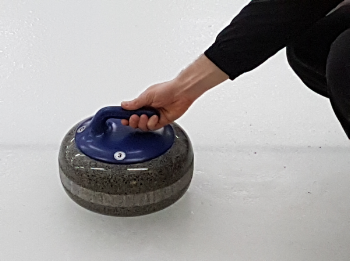Hear more about this subject and other curling topics from Jonathan Havercroft on Rocks Across the Pond: A Curling Podcast available on iTunes, Google Play, Stitcher, and TuneIn.
The 2018 World Men’s Curling Championship in Las Vegas was my first time going to a big-time curling event as a fan. Odd I know, having played for over 30 years. But for some reason whenever a Scotties or a Brier was close by, work or school or curling would conflict. And when the event was not close, the location did not seem enticing enough to justify a trip.
I mean nothing against Regina in March, but who really wants to travel to Regina in March (on purpose)? This year I was in San Francisco for a work conference the week of the Worlds and a flight to Vegas wasn’t too expensive, so I figured why not go to the closing weekend.
INTURN: Watching curling inside Orleans Arena
So what was the event like? Orleans Arena was great from a spectator perspective. It was just the right size (around 7,500 seats) and the sight lines were pretty good. However, I would have had a hard time seeing the sheet closest to my seats had I gone mid-week. Oddly, seats that are higher up along the side lines have better views than ones closer to ice level for curling.
Overall the venue did a good job of creating a positive experience for the fans. There was an announcer who did some kind of feature during each end break like you might see at a minor league baseball game. Sometimes it was a contest with a fan. Other times an interview with a curling celebrities like Ernie Richardson and John Shuster.
There is only one tweak I’d make. There was very little to no curling information relayed to the fans. In a certain sense curling is pretty self-explanatory, we can all see the game and watch the score. But there were a few episodes where odd things happened and there was no official explanation.
For example, in the Canada vs. Scotland semifinal the ice had to be reconditioned at the 5th end break and the players were then able to each throw one practice stone. I’ve never seen that happen before, and it would have been nice for the announcer to just give a quick explanation about the delay in game.
In terms of the games themselves the scores were not that close in the playoffs, but the shot-making was amazing! It is a world championship, so that shouldn’t be surprising. But we were treated to an Edin performance for the ages. Two or three times in the final my buddy and I would ask, “Is that shot even there?,” only to watch Edin execute it to perfection.
Gushue played lights out in the semifinal against Mouat, putting the game away with two perfect runbacks in a row. Mouat however put on his own shot-making clinic against the Koreans in a rout in the bronze medal game.
OUTTURN: The party atmosphere at Orleans Casino
Off-ice the experience was interesting. The strongest feature of this Worlds was the Pool Patch. Major curling events tend to have a large party room/bar where the fans go after games to hang out and party. The Orleans Resort has a giant pool. So during the day time they decided to have the party poolside.
They also had an evening patch in a ballroom and it was a bit of a snorefest. It was not well attended and the room had no ambience. It felt a bit like going to your boring cousin’s wedding. There were a few people drinking too heavily, some bad white person dancing by some old people and nobody having much fun.
I’m not really sure why the pool patch was so great (ED. NOTE: You seriously can’t figure that out?) and the night patch was so bad (ED. NOTE: Really? Still can’t put your finger on this one?). I’ve always heard stories about how great the Brier patch is and how the party goes on until late into the night. But here the Patch was dead by 11pm in a casino that runs 24/7 (ED NOTE: BECAUSE THERE WAS A CASINO THAT RAN 24/7 WHERE YOU DRINK FOR FREE.).
The resort itself had plenty to do in between matches. Obviously there is lots of ways to lose your money gambling. But there is also a bowling alley, 20 restaurants, the pool, a spa, a movie theatre and an arcade. You never have to leave the facility and to be honest we didn’t. I think it would get old if I had been there for the whole nine days of worlds, but it is a perfect place to watch curling for a weekend.
TAKEOUT: Final overview of the 2018 World Men’s Curling Championship
The announced attendance for the whole event was a little under 75,000, which was a new record for a world championship in the U.S. I would guess the arena was about 75 percent full for the final with a fairly heavy Canadian contingent. The crowd was probably 80 percent Canadian fans with a small but very vocal contingent of Swedes.
To be honest the European delegations, Sweden and Scotland, had way better chants than the Canadians. They brought a bit of a European football mentality to the arena. With organized chants for different players, and all the fans sitting together and color coordinated. The Canadian fans were loud and vocal, but not very inspired in their cheers (apart from calling for spin-o-ramas when the games were out of reach).
Overall it was a great experience. The Continental Cup is heading back to the Orleans Arena in 2019. That is probably the best place to watch high-caliber curling in the U.S. right now. So if you are looking for a curling vacation, you might want to give the 2019 Continental Cup a shot.


